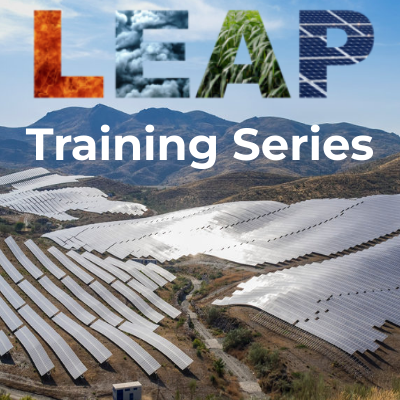Introductory training course on the Low Emissions Analysis Platform (LEAP) modelling tool for energy, environmental, and economic analysis

This training course is an output of the SEI Initiative on Integrated Climate and Development Planning, which leverages technological and methodological advances and strategic approaches to reach both climate and development aims. The initiative builds and reinforces capacity of in-country planners to achieve their goals, and to enhance their ambitions.
Introduction
This training introduces participants to the Low Emissions Analysis Platform (LEAP), a modelling tool for energy, environmental, and economic analysis that can be used to explore co-benefits of climate mitigation, including for air quality and health. LEAP is a powerful, versatile software system for integrated energy planning and climate change mitigation assessment, and is used by many countries for informing energy policy, climate mitigation policy, and supporting air pollution policy analysis at the national, multi-national or sub-national scales.
The LEAP tool is being continuously developed by SEI to improve its utility for policy. For example, LEAP has been linked with SEI’s Water Evaluation and Planning system (WEAP) tool to conduct integrated analyses of energy and water systems, andan update in 2020 has allowed countries to use LEAP to model energy storage and assess the health impacts of indoor air pollution for different groups including women and children. Future developments plan to expand its scope to cover topics such as land-use change, forestry and other aspects of development planning.
Even though LEAP is known for being user-friendly, it is still a sophisticated tool. For this reason, it is not easy for someone to casually apply it without some experience in the discipline of energy modelling. This training series provides the foundational experience needed for using LEAP.
An overview of the training course, prerequisites for using LEAP, pre-course actions and instruction, and the training course timetable can be found in the Sida LEAP training course programme (see Featured Download).
Training series lectures
This training series was structured as a remote workshop held on four days. Each day of the workshop consisted of a three-hour web meeting in which SEI presented key information and instruction on LEAP. During the first three days participants were assigned hands-on exercises to complete before the subsequent meeting.Completion of the exercises was essential for full participation in the training.
The lectures, presentation slides, and exercises for each day of the training series can be found through the following links:
- Day 1: Introduction to LEAP & Energy Demand Modelling
- Day 2: Energy Supply Modelling & Modelling Emissions
- Day 3: Cost Benefit Analysis & Optimization Modelling with LEAP and NEMO
- Day 4: Linking LEAP and WEAP for energy & water resource planning & Advanced Topics
These lectures are also provided as a video series on YouTube.
Learning outcomes
This training series focused on building familiarity with LEAP’s user interface and terminology, and on developing basic competency with:
- LEAP’s functionality for modelling energy demand and supply, energy-related emissions, and energy system costs and benefits.
- Optimization modelling with LEAP and the Next Energy Modelling system for Optimization (NEMO).
- Connecting LEAP to the Water Evaluation And Planning system (WEAP), a water resources modelling tool.
The training also provided an overview of LEAP’s use in Southeast Asia and informed participants about other LEAP capabilities they may wish to explore on their own.
Institutional background and trainers
The training was funded by the Swedish International Development Cooperation Agency (Sida) and led by the Stockholm Environment Institute (SEI), the developer of LEAP. The lecturers are:
- Jason Veysey, a Senior Scientist at SEI US focused on energy system modelling, climate change mitigation policy analysis, and modelling and policy capacity-building in developing nations.
- Charlotte Wagner, a Scientist at SEI US in the Energy Modelling Program, where she leads energy and environmental modelling, policy analysis, and capacity building projects and contributes to the technical development of SEI’s modelling tools.
Further resources and notes
Additional LEAP training resources, detailed LEAP training exercises, the complete LEAP User Guide, details of relevant courses, and an active community of practice can be accessed through the LEAP website and on the LEAP YouTube channel.
LEAP and its associated training materials and documentation are available free of charge to qualified academic, governmental and nonprofit organizations based in the low and middle income countries and to students worldwide. Consulting companies, utilities and other businesses can access LEAP through affordable licensing arrangements.
LEAP is distributed and supported by SEI through the LEAP web site, which has more than 36,000 members worldwide. Along with developing and supporting LEAP, SEI also develops LEAP-based scenario studies, helping policy-makers and planners explore their options to meet future energy needs, mitigate climate change, and shift to a low-carbon development pathway.
Citation Guidelines
Proper citation is important to the visibility and impact of the LEAP software system. We thank you for your commitment to cite LEAP correctly.
Please include the following citation when publishing any results, analyses, tables or images generated by LEAP in any form (e.g. print, electronic, etc.):
Heaps, C.G., 2022. LEAP: The Low Emissions Analysis Platform. [Software version: 2020.1.64] Stockholm Environment Institute. Somerville, MA, USA. https://leap.sei.org
(0) Comments
There is no content